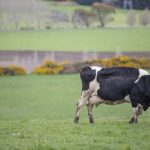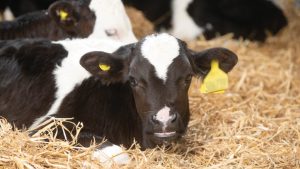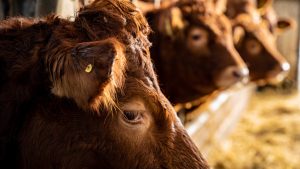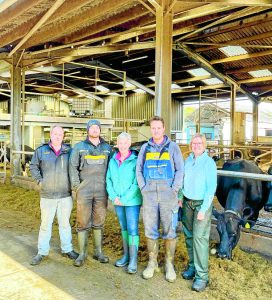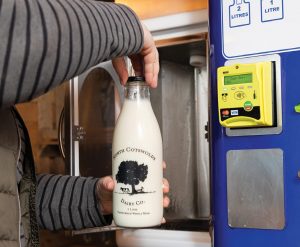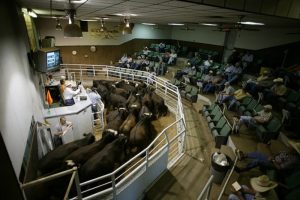
Four in five dairy farmers have experienced cryptosporidiosis in their herds, with significant financial and welfare implications, according to new research.
A study conducted at Harper Adams University found that 84% of surveyed farmers had dealt with cryptosporidiosis outbreaks, with nearly 60% rating the severity as 7 or higher, with 10 being the most severe.
The survey of 63 farmers from across the UK in spring 2024 highlighted financial losses ranging from £300 to £30,000, with 68% of respondents citing financial strain due to increased vet bills, extended rearing times, and lower sale values.
Almost three-quarters (70%) of respondents said affected calves were less profitable, with poor growth rates being the most common reason.
This mirrors other UK studies, which show that calves infected within the first 16 days of life gained significantly less weight over six months, leading to a potential £161 reduction in sale price per calf . Additional costs include increased labour for managing sick calves.
Cryptosporidiosis occurs when calves ingest the parasitic protozoan Cryptosporidium parvum (C. parvum), which produces vast numbers of encysted eggs (oocysts) shed in the faeces of infected animals.
Calves between five days and two weeks of age are most affected, with symptoms including colic (gut pain), reduced feed intake, watery scour, and dehydration.
The latest study was prompted by BSc Animal Production Science graduate Alice Powell, now a Ruminant Sales Specialist at Massey Feeds—a company offering specialist feed and milk products to support calf health—after witnessing the devastating effects of C. parvum first-hand.
“On one of the farms I worked at, there were a lot of calf deaths due to C. parvum, and the calves were severely dehydrated. You could just smell it in the sheds. After testing, they found they had C. parvum, so they became very strict about cleaning, disinfecting, and colostrum management.”
Ms Powell says the farm even invested in new calf accommodation with non-permeable surfaces that were easier to clean and disinfect.
Her study revealed gaps in biosecurity and prevention. Some of the measures ranked as most important also had a high number of farmers stating they were not important.
For example, 28 farmers considered thorough cleaning of feeding equipment very important, while 18 disagreed, stating it was not important. However, four in five farmers reported cleaning and disinfecting after an outbreak.
More than half of respondents were using preventive measures, with cleaning equipment, good colostrum management, and correct calving protocols ranked as the most effective.
One issue raised was that many farmers were either using the wrong disinfectant or unaware that only certain disinfectants are effective against cryptosporidiosis. Having the correct electrolyte protocol is also crucial.
Some farmers mentioned adding electrolytes to milk, but this can affect the osmolality in the calf’s digestive system, leading to dehydration rather than rehydration. Electrolytes must be provided separately from milk feeds,” she said.
Dr Kat Baxter-Smith from MSD Animal Health highlights the multifactorial nature of managing infectious calf scour, adding: “No single solution exists, but good biosecurity, vaccination, nutrition, and hygiene help minimise disease problems.”
Demand for new vaccine
The research also gauged awareness of Bovilis Cryptium®, the first-ever vaccine for cryptosporidiosis. At the time of the survey, it was not yet available in the UK, having only been launched in late 2024. However, 81% of respondents who were aware of it said they would use it if it became available.
Farmers cited better calf welfare, reduced mortality, and improved productivity as key reasons for wanting access to the vaccine.
Administered to pregnant cows in the third trimester, the vaccine requires two doses given 4–5 weeks apart, with the final dose completed at least three weeks before calving.
For subsequent pregnancies, a single booster dose is required. The vaccine can also be administered alongside Bovilis® Rotavec® Corona, which protects against rotavirus, coronavirus, and E. coli K99.
“By vaccinating cows in late pregnancy, antibodies against C. parvum are raised in colostrum, reducing clinical signs of disease in newborn calves. Calves should receive at least three litres of colostrum within six hours of birth and all calves should be fed colostrum and transition milk during the first five days of life.
“Calves gain protection against these pathogens by drinking the fortified colostrum from their vaccinated mothers,” explained Dr Baxter-Smith.
“When used alongside excellent colostrum management and strict hygiene, vaccination can significantly improve calf health and farm efficiency,” she added.
Farmers interested in further information should contact their local veterinary professional.
You can now read the most important #news on #eDairyNews #Whatsapp channels!!!
🇺🇸 eDairy News INGLÊS: https://whatsapp.com/channel/0029VaKsjzGDTkJyIN6hcP1K


